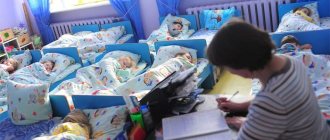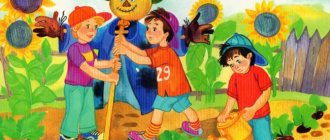The daily routine in kindergarten for all age groups of the kindergarten is based on SanPiN standards, and is designed for a 12-hour stay of a child in a preschool institution. The daily routine in a preschool institution is a strict, down to the minute, sequence of walks, meals, activities, games and daytime rest.
Peppa Pig
Peppa Pig
Thanks to such a regimented daily routine in kindergarten, the preschooler develops discipline, a love of order, and the ability to manage his own time, which will facilitate adaptation to school in the future.
In preschool institutions in our country, it is customary to divide children into groups by age. So, the early age group is from 2 to 3 years old; junior group - 3-4 years; middle group - 4-5 years; senior group - 5-6 years; preparatory group 6-7 years old.
However, regardless of the age of the preschooler, the daily routine in kindergarten begins at 7 am, when teachers receive children, and the “working day” in kindergarten begins at 8 am.
Approximate daily routine for a preschooler
7.00-8.30 - Reception of children 8.10 - Exercise 8.30 - Breakfast 9.00-10.00 - Classes 10.30-11.30 - Walk 12.00 - Lunch 12.30-15.00 - Day nap 15.30 - Afternoon snack 16.00-17.00 - Classes 17.00 - Pro party 18:00 - Dinner 19.00 - Care children home
As can be seen from the schedule, according to the recommendations of SanPiN, a kindergarten pupil is provided with four meals a day, with an interval of 4 hours between meals, there are also two walks, one of which is in the afternoon (the time of which may be reduced due to weather conditions), in addition, it is mandatory nap, and of course there is time for activities and games.
It is worth noting that there are slight differences in the daily routine of each group in kindergarten, which take into account the age characteristics of the children.
For example, if the duration of classes in the junior group of a kindergarten is only 10 minutes, then preschoolers of the senior and preparatory groups study for 20-30 minutes, which is close to school classes. The same applies to preparatory moments and getting ready - older children need less time to get dressed for a walk, or wash their hands before lunch.
Next, we will look at several important points from the daily routine in kindergarten in more detail.
Organization of the daily routine and its importance in raising children
Irina Savtsova
Organization of the daily routine and its importance in raising children
Organization of the daily routine , its importance in raising children
1. The concept and meaning of the daily routine . Its features in different age groups
The daily routine is of great importance for the health and physical development . A constant time of eating, sleeping, walking, playing and studying—what I.P. Pavlov called an external stereotype—is a prerequisite for the proper upbringing of a child .
routine is a clear routine of life during the day, providing for the alternation of wakefulness and sleep, as well as the rational organization of various types of activities. A correct regimen that corresponds to the child’s age-related capabilities improves health , ensures efficiency, successful implementation of various activities, and protects against overwork.
The physiological basis that determines the nature and duration of activity is the level of performance of the cells of the cerebral cortex, therefore it is so important not to exceed the performance limit of the central nervous system, as well as to ensure its full functional recovery after work. The degree of morphofunctional maturity of the organism determines the content routine and the duration of its main elements, among which the following are distinguished:
- dream;
– staying outdoors (walking)
;
– educational and training activities;
– gaming activities and activities of one’s own choice (reading, music, drawing and other creative activities, sports);
– self-care, family assistance;
– meals;
- personal hygiene.
Sleep ensures complete functional restoration of all body . The physiological need for sleep in children of different ages depends on the characteristics of their nervous system and health status. In the preschool period, both night and daytime sleep are required, regardless of whether the child attends a preschool educational institution, a short-stay group or not. A good night's sleep is important for both preschoolers and schoolchildren.
A child under 5 years old is supposed to sleep 12.5–12 hours a day, at 5–6 years old – 11.5–12 hours (of which approximately 10–11 hours at night and 1.5–2.5 hours during the day)
.
The time allotted for night sleep is from 9–9 hours 30 minutes in the evening to 7–7 hours 30 minutes in the morning. Preschool children sleep once during the day. They are put to bed so that they wake up at 15-15 hours 30 minutes. to organize a daytime nap later - this would inevitably lead to a later bedtime at night.
A six-hour wakefulness in the afternoon is exactly the period of time during which the child will play enough to feel the need for rest. Staying outdoors (walking)
– the most effective type of rest, due to increased blood oxygenation,
replenishment of ultraviolet deficiency, allowing for the hardening of the body and an increase in physical activity. Walks are especially important for children : in winter, at least 4–4.5 hours, and in summer, if possible, all day. The walk is not carried out at an air temperature below -15 °C and a wind speed of more than 15 m/s for children under 4 years old , and for children 5–7 years old at an air temperature below -20 °C with a wind speed of more than 15 m/s (for average stripes)
.
Educational and educational activities.
When building a rational training regimen, of the child’s body . In most healthy children, the greatest excitability of the cerebral cortex and performance are determined in the morning, from 8:00 to 12:00, and in the evening, from 16:00 to 18:00.
Training and education at preschool educational institutions provide for developmental activities. In the junior group, the duration of classes is 10–15 minutes (10 lessons per week, in the middle group (4–5 years)
– 20 minutes (10 lessons per week, in the senior group
(5–6 years old)
– two lessons a day for 20–25 minutes with a break of 10 minutes. In the preparatory group
(6–7 years old)
– 3 lessons per day are conducted according to 25-30 minutes, acquiring the character of learning. Hygienic studies have shown that classes on speech development, literacy, mathematics, and familiarization with the outside world are more tiring than modeling, drawing, designing. Physical education and music
(dynamic classes)
reduce or relieve fatigue.
One of the means of physical education is the correct implementation of a regimen compiled for each age group of children , taking into account their psychophysiological characteristics. If the regime is carried out correctly, then children are calm, actively engaged, play, eat well, fall asleep quickly and sleep soundly, and wake up cheerful and cheerful.
The routine for each age group indicates the approximate time that elapses from the inclusion of the first child in this routine process until the last child ends it.
The younger the children , the less independent they are, the more important it is to maintain the principle of gradualness when carrying out all routine moments .
It is important to make seasonal changes to your daily routine . The program offers modes for both cold and warm seasons.
In winter, due to the weather conditions and the large number of activities with children, the child’s time outdoors during the day is somewhat reduced.
Therefore, a walk is of particular importance , which is extremely important to carry out systematically at least 2 times a day. In summer and other warm periods of the year, the daily duration of children's stay in the fresh air , since the number of classes is reduced to one and almost all routine processes are carried out on the site if possible. Most activities with children - physical education, music, familiarization with the environment, etc. - should also be carried out in the fresh air.
In order for a walk to be not only useful, but also interesting, its content should be properly planned: conduct outdoor games, sports entertainment, introduce children to their surroundings , to nature, to the work of adults on the site, on the street, to involve children in work that is feasible for them. in the garden, going on excursions outside the site, etc.
When implementing the regime, it is necessary to ensure a timely change in the types of activities of children .
When planning work, the teacher provides that classes in which children move little (on the development of elementary mathematical concepts, drawing, etc.) are replaced by physical education and music classes. If children show signs of fatigue (excitement, inattention, motor restlessness, etc.) )
a physical education minute is held.
During the periods of time allocated in the regime for independent activity of children , much attention is paid to ensuring their physical activity.
Based on the best experience of preschool institutions and the achievements of pedagogical science, an approximate routine for each age group of a preschool educational institution, which is included in the “ Education Program in Kindergarten ”
.
The standard regime is designed for a 12-hour stay of children in a preschool institution.
Daily routine (in warm weather)
Regime processes 1st junior . gr. 2 jr. gr. average gr. senior gr. prepared gr.
Getting up, morning toilet 6.30–7.30 6.30–7.30 6.30–7.30 6.30–7.30 6.30–7.30
Reception, examination, games, morning. gymnastics 7.00–8.00 7.00–8.20 7.00–8.25 7.00–8.35 7.00–8.35
Preparation for breakfast, breakfast 8.00–8.30 8.20–8.55 8.25–8.55 8.35–9.00 8.35–8.55
Games, preparation for the walk, departure 8.30–8.50 8.55–9.15 8.55–9.20 9.00–9.15 8.55–9.05
Lesson (on site)
8.50–9.00 9.15–9.30 9.20–9.40 9.15–9.45 9.05–9.35
Games, observations, air and solar procedures 9.15–11.30 9.30–11.15 9.40–11.35 9.45–12.15 9.35–12.10
Return from a walk, water procedures, games 11.30–11.50 11.15–11.40 11.35–12.00 12.15–12.30 12.10–12.30
Preparation for lunch, lunch 11.50–12.30 11.40–12.20 12.00–12.35 12.30–13.00 12.30–13.00
Getting ready for bed, sleeping 12.30–15.10 12.20–15.10 12.35–15.10 13.00–15.00 13.00–15.00
Wake up, afternoon snack 15.15–15.35 15.10–15.30 15.10–15.30 15.00–15.25 15.00–15.25
Preparation for the walk, games 15.35–15.50 15.30–15.50 15.30–16.00 15.25–16.10 15.25–16.20
Walk, play outside, children go home 16.40–19.00 16.30–19.00 16.40–19.00 16.50–19.00 16.55–19.00
Daily routine (in cold weather)
Regime processes 1st junior . gr. 2 jr. gr. average gr. senior gr. prepared gr.
Getting up, morning toilet 6.30–7.30 6.30–7.30 6.30–7.30 6.30–7.30 6.30–7.30
Reception, examination, games, morning. gymnastics 7.00–8.00 7.00–8.20 7.00–8.25 7.00–8.30 7.00–8.30
Preparation for breakfast, breakfast 8.00–8.30 8.20–8.55 8.25–8.55 8.30–8.55 8.30–8.50
Preparation for classes 8.20–9.00 8.55–9.00 8.55–9.00 8.55–9.00 8.50–9.00
Classes 8.40–9.15 9.00–9.35 9.00–9.50 9.00–10.50 9.00–11.05
Games, preparation for a walk, walk 9.15–11.30 9.35–11.35 9.50–11.50 10.50–12.25 11.05–12.35
Return from a walk, games 11.30–12.10 11.35–12.00 11.50–12.15 12.25–12.40 12.35–12.45
Preparation for lunch, lunch 11.50–12.30 12.00–12.40 12.15–12.50 12.40–13.10 12.45–13.15
Getting ready for bed, sleeping 12.30–15.00 12.40–15.00 12.50–15.00 13.10–15.00 13.15–15.00
Wake up, afternoon snack 15.00–15.15 15.00–15.15 15.00–15.15 15.00–15.15 15.00–15.15
Games, self. artist activities, classes 15.15–15.40 15.15–15.50 15.15–16.00 15.15–16.10 15.15–16.20
Preparing for the walk, walk, games, children going home 16.20–19.00 16.30–19.00 16.40–19.00 16.50–19.00 16.55–19.00
Thus, for each age period, a regimen that takes into account the physiological needs and physical capabilities of children of a given age .
The emotional-positive state of the child during the day, the success perception of the surrounding reality depend on complete and timely feeding, high-quality and sufficient sleep, pedagogically well- organized wakefulness . A certain sequence of their alternation should be observed: sleep, feeding, wakefulness.
Organization of the daily routine in home education
Age-related features of the mental development of children 3–4 years old .
At the age of 3–4 years, the child gradually leaves the family circle. His communication becomes non-situational. An adult becomes for a child not only a family member, but also a bearer of a certain social function. The child’s desire to perform the same function leads to a contradiction with his real capabilities. This contradiction is resolved through the development of play, which becomes the leading activity in preschool age.
The main feature of the game is its convention: performing certain actions with certain objects presupposes their attribution to other actions with other objects. The main content of the play of younger preschoolers is actions with toys and substitute objects. The game duration is short. Younger preschoolers are limited to playing with one or two roles and simple, undeveloped plots. Games with rules are just beginning to take shape at this age.
A child’s visual activity depends on his ideas about the subject. At this age they are just beginning to form. Graphic images are poor. Some children 's images lack detail, while others' drawings may be more detailed. Children can already use color.
Modeling is of great importance Younger preschoolers are able to sculpt simple objects under the guidance of an adult.
It is known that application has a positive effect on the development of perception . At this age, children have access to the simplest types of appliqué.
Constructive activity in early preschool age is limited to the construction of simple buildings according to a model and design.
In early preschool age, perceptual activity develops. Children move from using prestandards - individual units of perception - to sensory standards - culturally developed means of perception . By the end of primary preschool age, children can perceive up to five or more shapes of objects and up to seven or more colors, are able to differentiate objects by size, orient themselves in the space of a kindergarten group, and with a certain organization of the educational process, in the premises of the entire preschool institution.
Memory and attention develop. At the request of an adult, children can remember 3-4 words and 5-6 names of objects. By the end of primary preschool age, they are able to remember significant passages from their favorite works.
Visual and effective thinking continues to develop. At the same time, transformations of situations in some cases are carried out on the basis of targeted tests, taking into account the desired result. Preschoolers are able to establish some hidden connections and relationships between objects.
In early preschool age, imagination begins to develop, which is especially clearly manifested in play, when some objects act as substitutes for others.
The relationships between children are determined by norms and rules. As a result of targeted influence, they can learn a relatively large number of norms, which serve as the basis for evaluating their own actions and the actions of other children .
Children's relationships are clearly manifested in play activities. They rather play nearby than actively interact. However, already at this age stable selective relationships can be observed. Conflicts arise mainly over toys. The child's position in the peer group is largely determined by the opinion of the teacher .
In early preschool age, one can observe a subordination of motives for behavior in relatively simple situations. Conscious control of behavior is just beginning to emerge; In many ways, a child’s behavior is still situational. At the same time, one can also observe cases of the child himself limiting his own motives, accompanied by verbal instructions. Self-esteem begins to develop, and children largely the teacher’s assessment . Their gender identification also continues to develop, which is manifested in the nature of the toys and stories they choose.
Approximate daily routine for children who do not attend kindergarten (according to V. E. Vasilyeva and A. F. Kaptelin)
1 Awakening, morning exercises, water procedures, washing 7–8.00
2 Breakfast 8.40
3 Games and activities at home 9.10 -10.00
4 Walk and play outdoors 10.10
5 Lunch 12.30–13.20
6 Daytime sleep (with the transom, window or veranda open)
13.30–15.30
7 Free time for quiet games and preparation for afternoon tea 15 -16.00
8 Afternoon snack 16.00
9 Walk and play outdoors 16.30
10 Dinner 18.30
11 Free time, quiet games 19 -20.00
12 Night sleep
Hours on weekends and holidays
If a child attends a kindergarten, his home regime on weekends and holidays must correspond to preschool regime The established daily routine should not be disrupted without a serious reason. If possible, it should be preserved even when the child’s living conditions change (for example, if parents send him to relatives for a while or take a long trip by rail with him). In certain cases, deviations from the regime are allowed within 30 minutes , but no more.
The accuracy of routine largely depends on how the baby himself regulates his behavior based on developed habits and self-care skills. Experience shows that strict adherence to the established routine day after day gradually develops the child’s active desire to carry out the routine independently , without prompting from adults, without coercion, and this contributes to the formation of such important qualities of behavior as organization and self-discipline , a sense of time, and the ability to save it.
Most preschoolers attend kindergarten, where they receive age-appropriate meals four times a day. Homemade diet in such an “ organized ”
The child’s diet should complement, and not replace, the kindergarten diet.
For this purpose, teachers post the daily menu in each group so that parents can familiarize themselves with it.
Therefore, when taking your child home, do not forget to read it and try to give your baby at home exactly those foods and dishes that he did not receive during the day. On weekends and holidays, try to stick to the kindergarten menu. The general routine of life is also very important. Unfortunately, in many families, especially young ones, the regime , and this inevitably harms the child.
According to our observations, children attending preschool institutions most often get sick after weekends and holidays. And this happens because at home the child is not provided with the regime to which he is accustomed, to which he tuned in in kindergarten: they put him to bed later in the evening, cancel daytime sleep, replace walks with games at home, allow him to watch TV shows as much as he wants, and overfeed him with sweets. All this negatively affects the fragile child’s body , disrupts the functions of all its organs and systems , thereby inevitably weakening the protective mechanisms.
home regime should be a continuation of the child’s institution regime , and if the child does not go to kindergarten, then at home he needs an age-appropriate and strictly observed daily routine. Without this, it is difficult to expect success from hardening.
On weekends, as on weekdays, you should not watch TV for more than 40, or at most 60 minutes. Rhythmic light stimulation coming from the TV screen has an adverse effect on the child’s brain and disorganizes its activity . These 40–60 minutes also include time for computer games.
On weekends you should spend more time outdoors. Walking with the whole family is especially beneficial both physically and psychologically.
On weekends, the child should take a walk, get some sleep, in a word – relax. Try not to let him get out of the usual rhythm of life, do not disturb the usual daily routine . By adhering to such simple rules, you and your baby will waste wonderful minutes of time, happily using them to be together, take a walk, and play. You will become friends with a good mood and well-being, and fatigue and lethargy will have to retreat.
What means help solve these problems?
First of all, the regime was developed in early childhood . Usually the child wants to somehow complete what he is doing (and this can only be welcomed)
. Therefore, you should warn your baby in advance, 10–15 minutes in advance, that you need to go to bed soon. And when this time comes, insist that the child does not linger.
The gradual switch from play to sleep is facilitated by the child’s habit of undressing on his own. By the age of three, a child can undress almost independently and neatly fold his clothes. Over the following years, these skills are improved.
The best clothes for sleeping are pajamas, which, depending on the season, can be flannelette, knitted or chintz. On hot days, children can sleep in panties (but not the ones they played in)
.
Let us remind you: in all seasons of the year, during the day, if possible, the child should sleep in the air. If this is not possible, then he must be dressed and covered in such a way that the window, transom or vent can remain open during the entire sleep time. (The air temperature in the room should not drop below plus 15°)
.
It is also very important to provide access to fresh air during nighttime sleep. If in winter the room gets too cold, it should be well ventilated before the child is put to bed.
It is advisable for the child to get up immediately after waking up. It should be borne in mind that the transition from sleep to wakefulness occurs differently in children : for some it is almost instantaneous, while for others it takes 5–10 minutes to finally wake up.
Dressing yourself and fastening all the buttons is somewhat more difficult for a child than undressing. Throughout preschool age, children should strengthen the skill of dressing themselves and carefully washing and combing their hair after sleep.
Walks.
A walk, long enough and done daily, is the most important means of improving a child’s health and his full and physical development. During the cold season, the child should walk at least 3-4 hours a day. If the weather is unfavorable, the walk can be shortened, but not cancelled. During the cold season, the mobility of some children is limited by dressing them incorrectly or wrapping them up too much. Bulky clothes make it difficult to play with peers, throw snowballs, or make snow “women”
, sledding down a hill, the child not only loses the joy of this fun, but begins to significantly lag behind in physical development.
In such children, adaptability to cold , heat, and resistance to the effects of harmful microorganisms .
They are often either too thin or too fat. Inharmonious physical development leads to a delay in improving motor skills. Often, walks are shortened because the adult who walks with the children is cold, because he moves much less than them . Therefore, it is very important that the adult is dressed and shod appropriately.
The combined effect of cool air and physical exercise is an effective method of hardening and training the most important functions of the body .
With the onset of warm spring days, children spend almost entire days outdoors. In spring, it is also very important to ensure that the child is dressed for the weather. If parents are not in a hurry to lighten the child’s clothes, then in the winter he will overheat. It’s hard for him, he unbuttons and sometimes takes off his coat - but this can lead to illness. Clothes should be lightened gradually: first, change a fur coat or warm coat to a spring coat with a knitted blouse or sweatshirt, then free the child from leggings, warm socks and etc. Later, on even warmer days, you can allow the child to walk with open arms and legs and, finally, in shorts. In the summer, when children develop the habit of walking around lightly dressed, you can leave them in lighter clothes on cool days.
Thus, serious organizational and educational work is needed among parents to streamline the home regime and bring it into line with that established in kindergarten. Parents' attention should be drawn to organizing an evening walk , a night's sleep, and on weekends to proper rest in the air, and regulating the viewing of television programs, especially before bedtime.
Kindergarten classes
As mentioned above, the duration of classes depends on the age of the child. A lesson in the junior group lasts 10 minutes, 15 minutes in the middle group, 20-30 minutes in the senior and preparatory groups.
In these classes, the preschooler learns a lot of new things, begins to form his horizons, and becomes familiar with the basics of writing and mathematics. If the kindergarten is specialized, with a certain focus, then additional classes may be included in the schedule. Also, the schedule in the middle and senior groups may include additional thematic classes and developmental clubs.
In kindergarten, not only the time of classes is regulated, but also their distribution throughout the day. The schedule is drawn up so that children not only do not become overtired, but also make the most of their activity.
Thus, classes that require increased concentration are carried out in the first half of the day, between 9 and 12 hours, all others - in the afternoon, between 16 and 18 hours. Activities that require perseverance and attention alternate with outdoor games and gymnastic warm-ups.
In addition, the most complex subjects, such as the basics of mathematics and writing, and speech development, are scheduled in the first days of the week, when preschoolers are most alert; for the rest (music classes, drawing, etc.) the second half of the week is usually reserved.
ABC of the regime
There are rules in all areas of our lives, and they also exist in observing the regime. As we said above, there is a diet for preschoolers, physical activity, sleep, games, and activities.
Diet. If we are talking about proper nutrition, then the regime is most accurately followed in preschool institutions, so it is worth focusing specifically on the organization of nutrition in kindergarten:
- at least 4 times a day;
- a hot meal at least 3 times a day;
- according to daily caloric needs: breakfast 25%, lunch 40%, afternoon snack 15%, dinner 20%;
- according to the daily calorie intake: 5 years – 2000 kcal, 6 years – 2200 kcal, 7 years – 2400 kcal;
- by quantity - you should not give a portion larger than the child usually eats (it is better to add a supplement).
The menu should include meat and dairy products, bread, vegetables and fruits every day.
In terms of time, the mode is built like this:
- breakfast at 8-9 o'clock,
- lunch at 12-13 o'clock,
- afternoon tea at 15-16 hours,
- dinner at 18:30-19:30 hours.
Meal times should be the same on weekdays and weekends.
It is advisable that the last meal be an hour and a half before bedtime.
Mode of physical activity and rest. Every day a child makes many movements, so physical activity means not only physical education, but also active games, sports, movement and relaxation. And here, too, there is a regime that ensures proper physical development.
- The peak of physical activity should occur in the first half of the day.
- Weekly physical activity for children 5-7 years old is 6-8 hours per week, according to SanPiN.
- Morning exercises are required.
- Physical education classes in a preschool institution - 3 times a week: children 5 years old - 25 minutes, children 6-7 years old - 30 minutes.
- Outdoor active games while walking (in bad weather they are replaced by a full set of exercises indoors).
- Physical education minutes between mental activities.
- Exercising after a nap.
- Moderately active games on the second walk.
Moderate physical activity should be observed immediately before breakfast, before mental activities and in the evening before bed.
Sleeping mode. A proper sleep schedule helps restore your baby's mental and physical strength that was spent on the active part of his day. Not only his psycho-emotional state, but also his physical health depends on how a child’s sleep is organized. Healthy sleep means strong immunity. And now, in order.
- Duration of sleep for preschoolers: 5-6 years – 12 hours, 7 years – 10-11 hours. But much is individual - depending on temperament and workload, the required time for sleep may increase.
- Morning awakening should occur at 7:00-8:00, it depends on biorhythms and family habits, but you should not wake up later.
- Daytime sleep in children 5-6 years old lasts 1-1.5 hours. At 7 years old, a baby may refuse to sleep, but active children need about 1 hour of sleep.
- Evening bedtime depends on the presence of additional physical or emotional stress. It is recommended that children aged 5-6 years go to bed at 20:30 - 21:00. At 7 years old it is possible to shift the time of falling asleep by half an hour.
Mode of exercise (mental activity). Both kindergarteners and children who do not attend kindergarten are not deprived of developmental activities in preschool age. But like any other activity, the time and number of classes must be correctly distributed and systematized. In other words, the home regime should not differ much from the regime in preschool institutions. The organization of classes in the general daily routine is as follows:
In the morning after breakfast - two or three multidirectional classes. Duration of classes according to age: 4-5 years – 20-25 minutes per type; 6-7 years – 30-35 minutes.
If the walk is cancelled, you can add another creative activity or educational game.
Meals
The main meals in kindergarten are breakfast, lunch, afternoon snack and dinner, if the child is in kindergarten until 19:00.
In all preschool institutions, regardless of their focus, meals are scheduled at approximately the same time: at 8.00-8. 30 breakfast, 12.00-13.00 lunch, 15.00-15.30 afternoon tea, 18.00 dinner.
In the daily routine according to SanPiN, each meal is preceded by preparation: children wash their hands and sit down at tables. The time for this preparation is also regulated and reduced depending on the age group.
Benefits of kindergarten education
Benefits of kindergarten education
Not all children attend preschool institutions - some have mothers who do not work, others have grandmothers. Most kids have to go to kindergarten, spending almost the whole day there. This necessity is not a disadvantage of parenting. On the contrary, it teaches children the perception of an organized team, whose life is subject to a certain routine.
Advantages of regime education
- The daily routine creates conditions for independence skills. Toddlers learn to dress, clean up after themselves, follow hygiene rules, and take care of their natural needs faster than children at home.
- In a preschool institution, a certain time is allocated not only for eating and sleeping, but also for group games, thereby promoting the development of the ability to share toys, help each other, relieving children of egocentrism.
- Much attention is paid to classes. Their content depends on the age group, but each lesson is selected taking into account the mental development of children. During classes, children learn logical thinking, oral speech, and demonstrate their musical and artistic abilities.
- The daily routine also includes hours for physical exercise and walks in the fresh air, which allows children to grow up healthier. Mobility makes it possible to usefully spend accumulated energy. This promotes good appetite and sleep.
By obeying the routine in kindergarten, children become more organized in the family. At the same time, they learn to moderate their personal desires and more often take into account the needs of people close to them.
Walks and quiet time
These important components of the daycare routine are also age-appropriate.
Children from the early age group go for a walk earlier than others, at 9.00-9.30. The quiet hour has also been increased - babies sleep on average from 12.30 to 15.00.
Children from the senior group and the preparatory group go to a quiet hour at 13.00; their sleep lasts an average of 1.5 hours. They also have a shorter time to prepare for a walk - children at this age can already independently and quickly change clothes for playing in the fresh air.
However, regardless of age, quiet time in kindergartens ends at 15.00. After afternoon tea, the younger groups have a general education lesson; students from the middle and older groups are engaged in games or independent activities.
During the second walk, the children are gradually picked up by their parents. In winter, due to the fact that it gets dark quite early, the time for the second walk is reduced, and children are taken directly from kindergarten. Also, the walk may be shortened due to weather conditions: for example, frost or strong wind.
Factors that help maintain healthy sleep in children
Failure to comply with any of the points will cause the development of insomnia.
The famous pediatrician Evgeniy Olegovich Komarovsky compiled a list of recommendations to help parents:
| Advice | Description |
| Decide on priorities | Irritated and sleep-deprived parents pass on their mood to their children, provoking the development of insomnia due to stress. Correct prioritization will help you avoid problems. You need to remove unnecessary things from your schedule and find 8 hours for proper rest. |
| Think about your sleep schedule | When drawing up a sleep-wake schedule, it is necessary to take into account the work of adults, the child’s school or kindergarten, and generally accepted standards. You need to follow the regime strictly, otherwise your daily biorhythm may get lost. |
| Solve the bedroom issue | Up to 3 years of age, it is permissible to arrange a child’s sleeping place next to his parents. In the future, it will be necessary to “relocate” to the nursery. Pediatricians do not recommend sleeping in the same bed with mom and dad. |
| Control daily rest | You need to add up the time spent on daytime and nighttime sleep. The final figure should be close to normal. If the child sleeps a few hours more at lunchtime, then there is a high probability of a long bedtime in the evening. |
| Understand your feeding schedule | Newborns are fed several times a night. Doctors advise making the penultimate portion smaller and giving more food before bed. From 6 months, hunger ceases to be the cause of awakenings. |
| Stay outdoors | Children need to play outside during the day to burn off excess energy and develop physically. Immediately before bedtime, it is better to limit yourself to a short walk to maintain psycho-emotional balance. At home, you can read a fairy tale and turn on gentle and quiet music. The sleeping area should be ventilated 20 minutes before the intended bedtime. |
| Improve the atmosphere in the bedroom | A dark and quiet environment is necessary for sleep. If your child cannot sleep without light, it is easier to purchase a night light. The temperature in the bedroom should not be higher than 22° with air humidity from 40 to 60%. |
| Apply water procedures | Swimming in the evening is exhausting and helps you fall asleep quickly. Exercises performed before water procedures will help enhance the hypnotic effect. |
| Choose quality bedding | The mattress should be flat and not sag under the weight of the child. A pillow is selected from the age of two. The standard size of 40 by 60 cm is suitable as a guide. The thickness is measured according to the width of the child’s shoulder. Bed linen is selected from natural fabrics. Synthetics may cause an allergic reaction. It is recommended to wash only with the addition of baby powder. |
| Keep your diaper clean | Before going to bed and when you wake up, you need to check the diaper. If the child has relieved himself, it will need to be replaced and the skin cleaned. |
| Get examined in a timely manner | You should contact your pediatrician for a routine examination once every 6 months. It is advisable to conduct a full examination every 2 years. |
Sleep requirements vary depending on a person's age. Newborns rest for over 18-20 hours a day, and children in high school no more than 8-9. Deviation from generally accepted indicators is not considered a pathology if the difference is small and the child feels well. You need to be wary of signs of sleep deprivation.
Games, joint and independent activities
Games and shared activities are very important for children. They teach children to communicate, develop creative thinking and imagination. During joint classes, a group of children completes tasks proposed by the teacher, thus preschoolers learn to work in a team and develop communication skills.
A total of three hours are allotted for independent games and activities, which allows the child to devote time to his own interests. Children play during the remaining time in such a tight schedule: before morning exercises, before and after classes, during walks.
- share with your friends!










